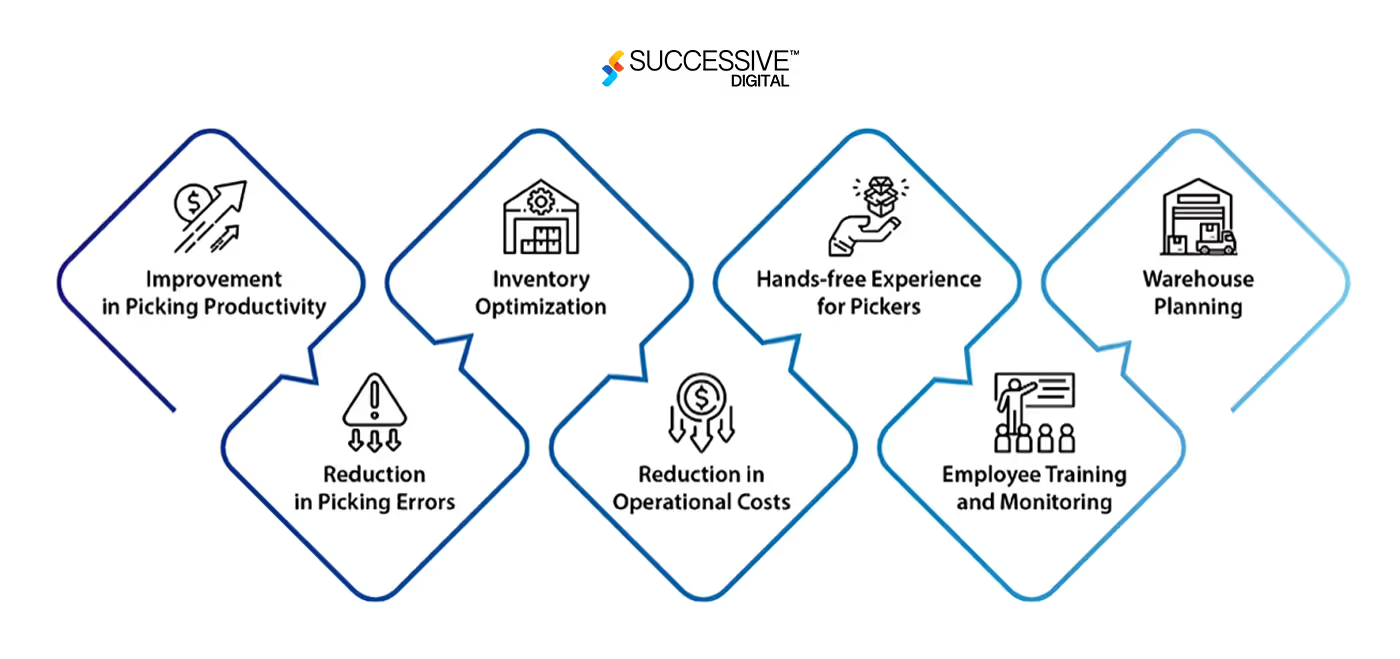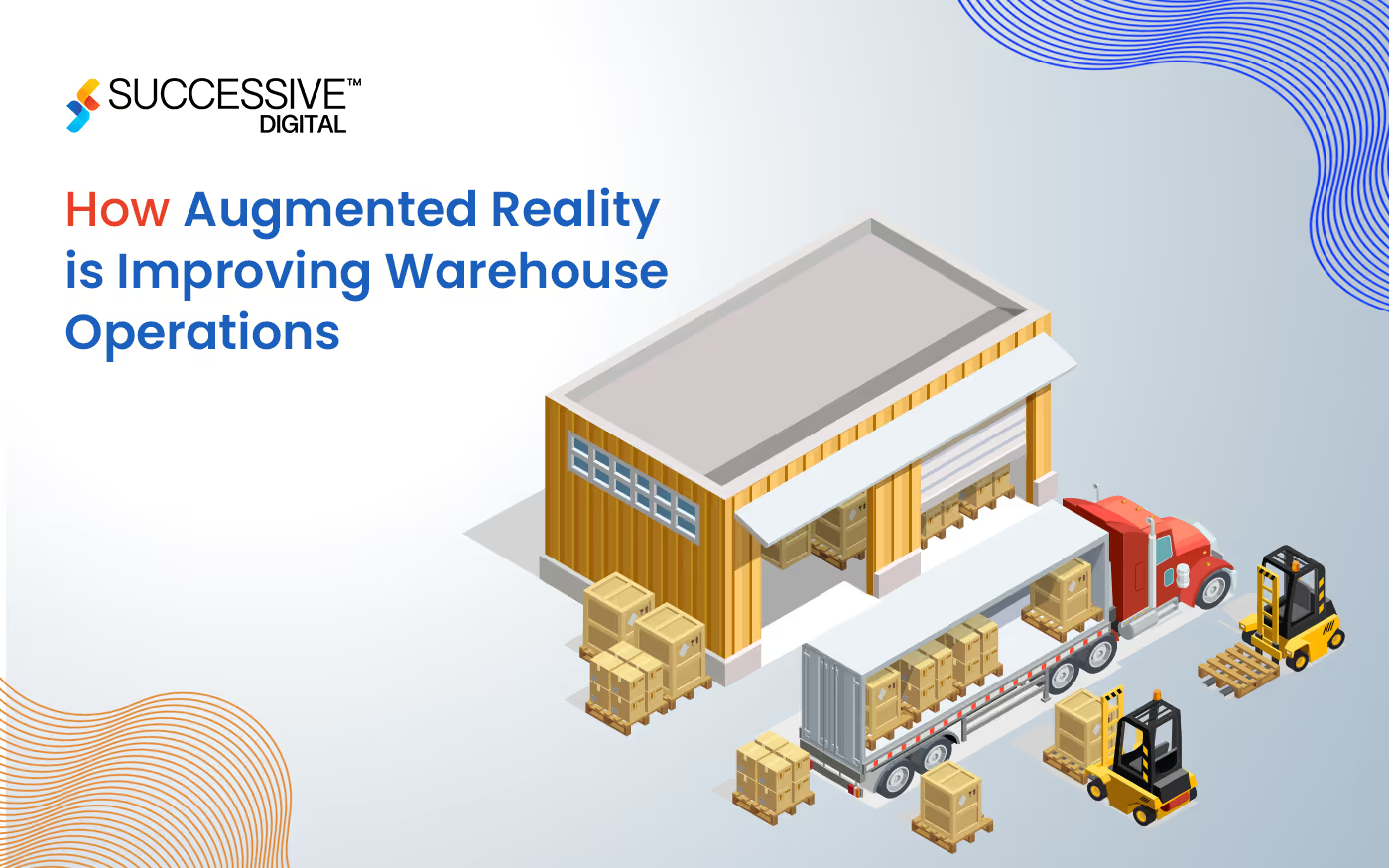In digital transformation space, augmented reality (AR) is emerging as a modern technology, reshaping numerous aspects of transportation and logistics operations. One of the most impacted uses of this is seen in AR warehouse management, where it complements performance, accuracy, and productivity. This article explores the technical intricacies of AR and how it is improving smart warehouse operations, ensuring more efficient logistics and distribution operations.

AR in Warehouse Operations: The Technical Foundation
The integration of augmented reality in warehouse operations leverages several technological improvements:
- Hardware: AR devices like smart glasses (e.G., Google Glass, Microsoft HoloLens) and hand-held gadgets (e.G., smartphones and capsules) serve as primary interfaces. These gadgets come geared up with cameras, sensors, and processors that render real-time information overlays.
- Networking: A strong networking infrastructure, such as Wi-Fi, 5G, and the Internet of Things (IoT), ensures seamless records change among AR devices and primary warehouse management structures (WMS).
- Software: AR warehouse control systems are powered by advanced software program that leverages computer vision, system studying (ML), and data analytics. These applications procedure real-time data from the warehouse environment and show useful information on AR gadgets.
- Data Integration: AR systems integrate with WMS, ERP (Enterprise Resource Planning) systems, and other databases to retrieve and show actual-time information, which includes stock reviews, order info, and storage places.
Key Applications of AR in Warehouse Operations
- Inventory Management
One of the primary applications of augmented reality warehouse solutions is stock control or inventory management. AR can extensively improve the accuracy and velocity of stock monitoring.
- Real-time Inventory Tracking: AR-enabled devices can scan barcodes or RFID tags, updating the stock database. This reduces the need for manual data entry and minimizes mistakes.
- Visual Guidance for Inventory Counting: AR devices can route workers to unique objects and show designated information, such as amount and storage situations, during inventory audits. This streamlines the auditing technique and ensures better accuracy.
- Order Picking
Order selection is a vital and time-consuming task. AR warehouse management solutions can make this process more efficient and error-free.
- Pick-by-Vision Systems: AR glasses can show picking instructions directly inside the employee’s field of vision, showing the best path to the goods location. This reduces the time spent trying to find inventory and increases picking speed.
- Hands-Free Operation: With augmented reality warehouse solutions, workers can move more free-hand, as they do not want to hold hand-held scanners or lists of inventories. This improves the overall productiveness, as workers can flow more effectively and deal with items with both hands.
- Error Reduction: AR can highlight the exact item to pick, ensuring workers to select the appropriate products. This reduces the possibilities of picking errors, increasing fulfilment and customer satisfaction rate.
- Training and Onboarding
Training new warehouse workers may be a time-consuming and resource-intensive process. AR can expedite training and improve its effectiveness.
- Interactive Training Programs: AR warehouse management can create interactive and immersive education experiences. New employees can study in-dept with guided tours via AR instructions that overlay real-world systems and scenarios.
- Simulated Environments: AR can simulate one-of-a-kind warehouse environments and eventualities, allowing trainees to learn and exercise without disrupting real operations. This prepares them for the diverse conditions they might encounter at the time of main activity.
- Maintenance and Repairs
Maintaining warehouse equipment is important for smooth operations. Augmented reality applications can be an effective resource in maintenance and repair procedures for Self-storage Facility Providers.
- Step-by-Step Repair Instructions: Augmented reality in warehouse or self-storage facilities can display step-through-step repair commands overlaid on the actual devices. This assists technicians in performing repairs correctly and efficiency.
- Remote Assistance: AR can also facilitate remote assistance from professionals. Technicians can leverage AR view with remote experts, who can then provide real-time guidance and troubleshooting recommendations.
- Safety and Compliance
Safety is paramount in warehouse operations. AR can enhance safety measures and ensure compliance with rules.
- Real-Time Hazard Alerts: AR can alert workers to capacity hazards in real time. For instance, if a worker is approaching a restrained location or a transferring forklift, the AR tool can show caution.
- Compliance Checks: Augmented reality warehouse solutions can guide workers via compliance checklists and approaches, making sure that all safety protocols are accompanied as they should be.
Benefits of AR in Warehouse Operations
The implementation of AR warehouse management offers several benefits:
- Increased Efficiency: AR streamlines various warehouse processes, reducing the effort and time required for responsibilities like stock management, order selection, and training.
- Better Safety: AR enhances protection by providing real-time hazard signals and ensuring compliance with security protocols. This reduces the danger of injuries and accidents in the warehouse.
- Enhanced Accuracy: By providing real-time information and guidance, AR minimizes human mistakes, which is mainly due to higher accuracy in responsibilities along with inventory tracking and order achievement.
- Improved Productivity: AR warehouse management allows workers to carry out tasks more quickly and efficiently, boosting common productivity. Hands-free operation and optimized workflows contribute to this improvement.
- Scalability: AR warehouse solutions can be scaled to deal with the developing needs of the warehouse. New devices and applications can be included seamlessly into the existing system.
- Cost Savings: While preliminary funding in AR technology can be sizable, the long-term financial savings are considerable. Reduced errors, quicker tactics, and decreased education prices contribute to overall cost savings.
ConclusionAugmented reality (AR) in warehouse management is reworking logistics and transportation operations in warehouses with the help of substantially improving efficiency, accuracy, and safety. By implementing AR applications in stock management, order fulfilment, training, and safety protocols, the technology is reshaping warehouse operations. Despite certain challenging situations, the benefits of AR surpass the drawbacks. As digital transformation and technological improvements progress, AR's function in warehouse operations will keep growing, leading to smarter, more efficient, and more secure warehouses.
.avif)










.jpg)









